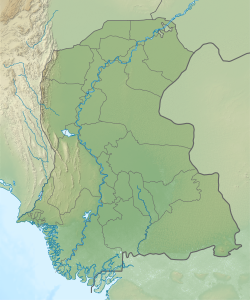Sann, Sindh
Sann (Sindhi: سن) | |
|---|---|
| Coordinates: 26°02′25″N 68°08′15″E / 26.040299°N 68.137632°E[1] | |
| Country | Pakistan |
| Region | Sindh |
| District | Jamshoro |
| Taluka | Manjhand |
| Time zone | UTC+5 (PST) |
| • Summer (DST) | UTC+6 (PDT) |
Sann is a small town and union council[2] located in Manjhand taluka of Jamshoro District, Sindh Province, Pakistan.[3][4] It lies on the western bank of the Indus river, at the mouth of an intermittent stream that brings down water from the Lakhi hills when it rains.[3] The town is located midway between Manjhand and Amri on the main Sehwan-Kotri trunk road.[3]
Ranikot, the world's largest fort, is about 30 km southwest of Sann.[5]
The Sindhi nationalist leader G. M. Syed was born in Sann, and his birthday is celebrated here annually.[6]
History
Under the Mughal Empire, Sann formed a pargana in the sarkar of Sehwan.[7] Sann was noted for its indigo production; according to the Mazhar-i-Shahjahani, local landowners installed Persian wheels to help irrigate the indigo crop.[7] Records of English factors indicate that indigo from Sann was sold in Thatta and then exported to Europe.[7]
In the early 1600s, the Mughal governor of Sehwan, Shamshir Khan Uzbek, had a fort built in Sann, and established a thana here under the command of his relative Khwaja Jan.[8] Later, during the tenure of the governor Ahmad Beg Khan (who held office from April 1628 until at least late 1629), Sann was attacked and looted by Samejas and Nuhmardis.[8] After this, Ahmad Beg Khan had a wall constructed around the town; Yusuf Mirak wrote in the Mazhar-i-Shahjahani (1634) that the wall was still standing at that time.[8] Under the governor Dindar Khan (Ahmad Beg Khan's immediate successor, who was transferred away in late 1633) Sann and its fort were again attacked by the pargana's arbabs, Sayyid Yusuf and Sayyid Jung, who had allied with the Samejas and Nuhmardis against the governor.[8]
Around 1874, Sann's population was estimated at about 1,000 people, split about 50-50 between Muslims (mostly Memons and Mohanas) and Hindus (mostly Lohanos).[3] It was the seat of a tappedar and had a dharamshala and a small police post.[3] It was not a significant commercial or industrial centre in its own right, although trading caravans passed through the town on their way south from Afghanistan.[3]
Notable personalities of Sann
G.M. Syed is a famous personality of Sann, Sindh. His grandson Syed Jalal Mehmood Shah also belongs to this town. Population 8,500
See also
References
- ^ "Geonames Search". Do a radial search using these coordinates here.
- ^ "Union Council wise Thematic Analysis". Department of Health, Government of Sindh. Retrieved 25 December 2021.
- ^ a b c d e f Hughes, A.W. (1874). A Gazetteer of the Province of Sindh. London: George Bell and Sons. pp. 696–7. Retrieved 25 December 2021.
- ^ "List of Dehs in Sindh" (PDF). Sindh Zameen. Retrieved 25 December 2021.
- ^ Soomro, Farooq (7 October 2014). "Mysterious Ranikot: 'The world's largest fort'". DAWN.COM. Retrieved 27 November 2024.
- ^ Chandio, Amir Ali (2009). "An analysis of Jeay Sindh Tahreek as an ethno-nationalist movement of Pakistan". Pakistan Perspectives. 14 (1): 105. Retrieved 28 December 2021.
- ^ a b c Paliwal, Amita (2010). Sind in the Mughal Empire (1591-1740): A Study of Its Administration, Society, Economy and Culture. Aligarh: Aligarh Muslim University. pp. 129, 142, 169, 171, 191, 198. Retrieved 28 December 2021.
- ^ a b c d Akhtar, Muhammad Saleem (1983). Shāhjahānī of Yūsuf Mīrak (1044/1634) Sind under the Mughuls: an introduction to, translation of and commentary on the Maẓhar-i Shāhjahānī of Yūsuf Mīrak (1044/1634). pp. 245–6, 289, 291–2, 319, 358–9, 393–4. hdl:1885/11279. Retrieved 28 December 2021.


